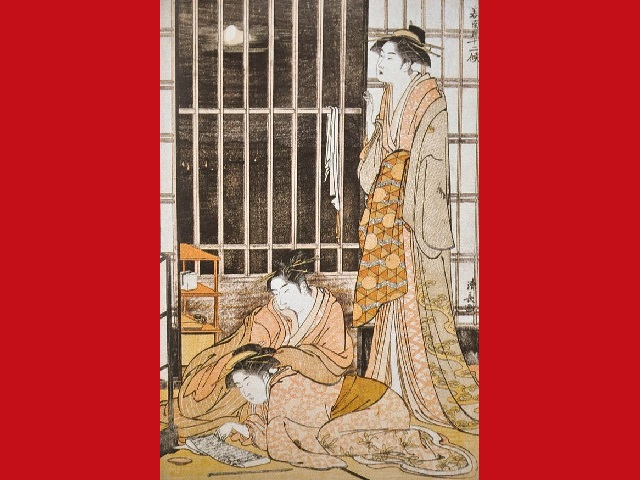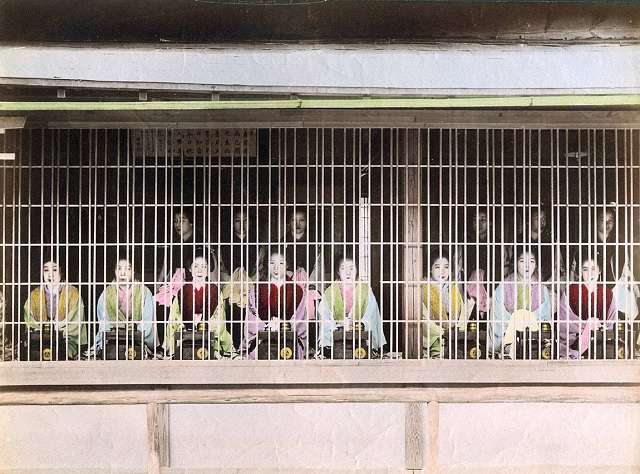The depressing diet of a Tokyo prostitute during Japan’s Edo period

Yoshiwara was once where men with money to burn came to entertain themselves, while this woman was eating rotten pickles, or sometimes nothing at all.
In Japanese entertainment media, the Edo period is an often romanticized part in the country’s history, and it’s not hard to see why. Lasting from 1615 to 1868, the Edo period is sandwiched between centuries of bloody civil war and the rapid industrialization and expansionist policies which put Japan on the path to the international conflicts that ultimately resulted in its defeat in World War II.
So in the popular imagination, the Edo period is frequently thought of as a peaceful interlude in which Japan was both free of internal conflict and isolated from the complications of the larger world. Sometimes, even the Edo era’s pleasure quarters are viewed through rose-colored lenses, with novels, manga, and movies centered on beautiful courtesans whose charms and insightful wisdom turn the story of her life into a colorful and lavish tapestry of the sunset of Japan’s shogunate days.
But reality wasn’t always so luxurious for the women who serviced men’s desires in Edo’s brothels, as shown in this excerpt from historical researcher Yuriko Yokoyama’s Umemoto Records, which records the meals eaten by a prostitute working in the Yoshiwara pleasure quarter of Edo (present-day Tokyo) in 1850.
▼ The list was displayed as part of an exhibition on gender inequality in Japanese history, attended by Japanese Twitter user @kusikurage.
「性差の日本史」展で見た衝撃の資料の一つがこの、とある江戸末期ごろの遊女の食事の記録。こんなん普通に飢えて死ぬやろというレベル。でも生きて、しかも夜遅くまで客を取らされていたというのだから。平均寿命(年齢じゃなく寿命)が19〜20歳だったというのも頷ける。 pic.twitter.com/GYeYuE9VxH
— 櫛 海月 (@kusikurage) November 29, 2020
The list was compiled by the woman herself, who recorded her morning and evening meals in her diary between March 7 and April 6.
3-7 Morning: Rotten pickles and ochazuke [rice with green tea poured over it]
Evening: Rice gruel) with salmon head
3-8 Morning: Warm rice with rotten pickles
Evening: Did not eat
3-9 Morning: Rice gruel with greens
Evening: Pickles and ochazuke
3-10 Morning: No entry
Evening: No entry
3-11 Morning: Pickles and ochazuke
Evening: Stewed clams
3-12 Morning: Pickles and ochazuke
Evening: Bad pickles and ochazuke
3-13 Morning: Rice gruel
Evening: Roasted mitsuba celery roots
3-14 Morning: Rice gruel
Evening: No entry
3-15 Morning: Did not eat
Evening: Did not eat
3-16 Morning: Did not eat
Evening: Did not eat
3-17 Morning: Rice gruel with dried daikon leaves
Evening: Did not eat, secretly partook of roasted beans and sake
3-18 Morning: Pickles and ochazuke
Evening: Pickles and ochazuke
3-19 Morning: Did not eat (shiodachi fasting [a practice of not eating in order to receive a desired blessing])
Evening: Pickles and ochazuke
3-20 Morning: Rotten pickles and ochazuke
Evening: Clam soup and rice
3-21 Morning: Was asleep
Evening: Clam soup and warm rice
3-22 Morning: Was asleep
Evening: Pickles and ochazuke
3-23 Morning: Rice porridge and pickles
Evening: Rice porridge and pickles
3-24 Morning: Potato soup and warm rice
Evening: Rice gruel with potato, was not given pickles
3-25 Morning: No entry
Evening: Pickles and ochazuke
3-26 Morning: Rice gruel with potato
Evening: Pickles and ochazuke
3-27 Morning: Warm rice and pickles
Evening: Ochazuke
3-28 Morning: Pickles and ochazuke
Evening: Was allowed to eat two sardines. Drank sake
3-29 Morning: Was asleep
Evening: Rice porridge
3-30 Morning: Warm rice and pickles
Evening: Ochazuke
4-1 Morning: Daikon radish strip soup and warm rice
Evening: Rice gruel
4-2 Morning: Pickles and ochazuke
Evening: Pickles and ochazuke
4-3 Morning: Pickles and ochazuke
Evening: Pickles and ochazuke
4-4 Morning: Pickles and ochazuke
Evening: Pickles and ochazuke
4-5 Morning: Cracked barley soup
Evening: Pickles and ochazuke
4-6 Morning: Cracked barley soup, clams
Evening: No entry
▼ A Yoshiwara brothel, with prostitutes on display in a caged window

It’s worth bearing in mind that even in 1850, across the board Japanese people’s diets consisted, proportionately, of far more rice and pickles than they do today. Beef, pork, and chicken were also not commonly eaten during the Edo period and many of the historical periods preceding it. So by modern standards, even an Edo person of moderate means would likely appear to be eating decidedly meager meals. The specific mentions of “warm” rice, as though it’s a special treat, may not have been entirely unique to the prostitute’s position either, as living in an age without electric rice cookers or microwaves meant making a fresh batch of rice wasn’t as quick and easy as it was today, and heating up leftovers on their own wasn’t always possible (thus all the times porridge, gruel, and ochazuke are listed instead of plain rice).
That said, the woman’s diary lists several times when she didn’t eat at all, most shockingly when over three days, March 15 to 17, she had just one meal, and it’s not hard to reason that some of those “slept through morning meal” entries are due to exhaustion from the previous night’s work. There’s also more than one mention of rotten pickles, and even when there’s something to eat that’s neither rice nor rotten, it’s sometimes the least desirable portion, such as daikon leaves (as opposed to the root vegetable itself) or salmon head (as opposed to a meatier, more nourishing cut).
@kusikurage claims that the average life expectancy of Edo-period prostitute was a mere 20 years. Again, life expectancies in general were much shorter in Japan in the 1850s than they are today, when they’re some of the highest in the world, but 20 is still incredibly young. That doesn’t necessarily mean that the women of Edo’s brothels were all starving to death, but sporadic, low-nutrition meals couldn’t have been good for the diary writer’s overall constitution, especially in a profession that carries so many other health risks as well, and it’s a reminder that as intriguing as the past may be, the present is overall a much nicer time to be living in.
Source: Yuriko Yokoyama via Twitter/@kusikurage via Hachima Kiko
Top image: Wikipedia/Ismoon (edited by SoraNews24)
Insert image: Wikipedia/Gryffindor
● Want to hear about SoraNews24’s latest articles as soon as they’re published? Follow us on Facebook and Twitter!
Credit:

0 comments: